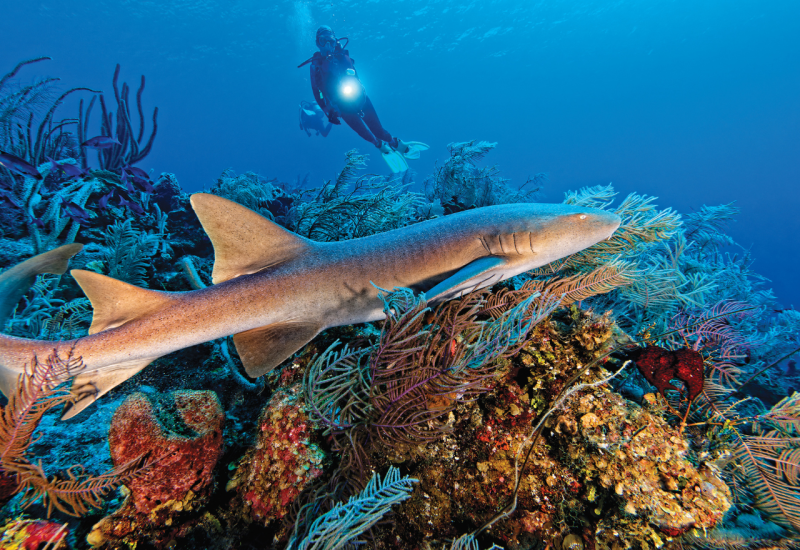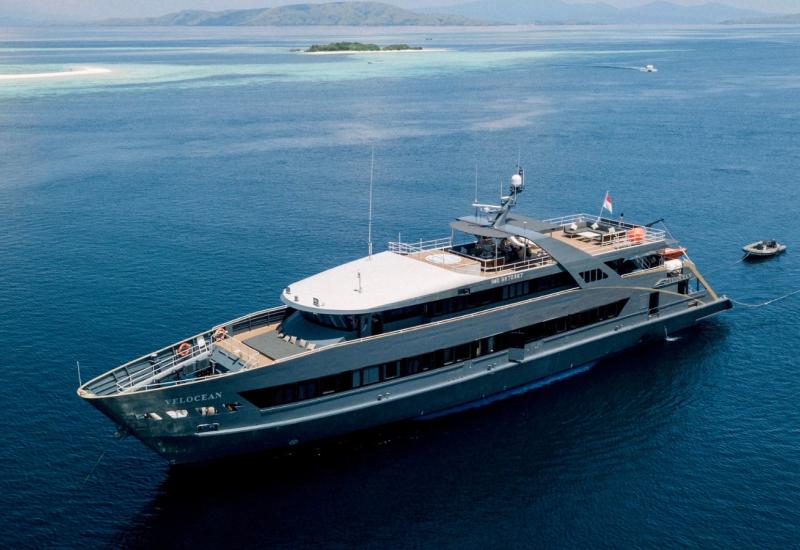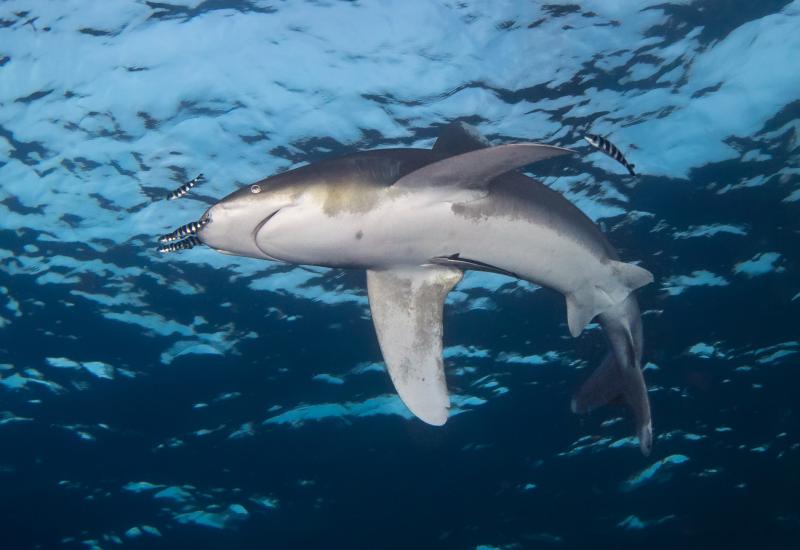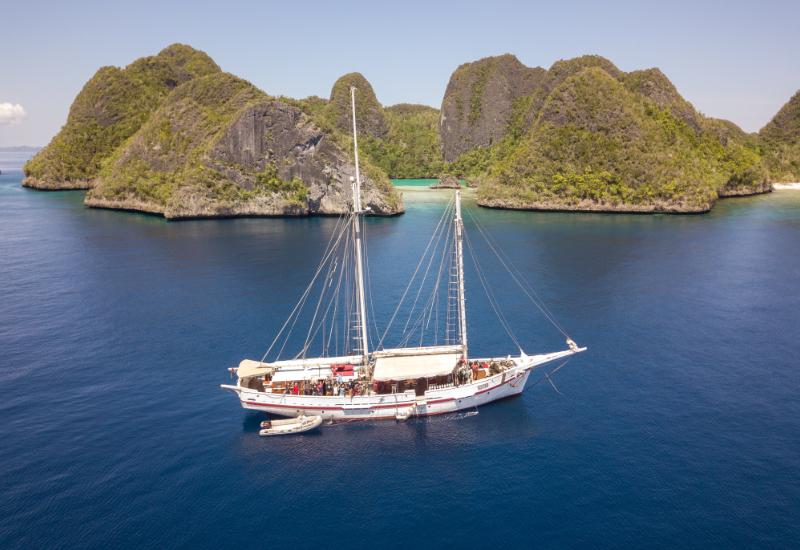Video: The Editor in Galapagos, Day 3
We got a late start to the morning, as the boat departed last night and cruised 122 miles north to Wolf Island. Arrived at 11 a.m., and we immediately got in at the Landslide. It was a decent dive, with single hammerheads and always the promise of a larger school on the edge of our visibility (which never materialized). I got great turtle footage, and saw my first Galapagos and silky sharks. Better yet, the visibility was distinctly better and that made everybody happier.
The second dive started better than the first, with a pair of sea lions at the very beginning. The female came in to give each of us a close inspection while the male stayed farther away. I had better hammerhead action on this dive, positioning myself on a sharp pinnacle that rose 20 feet from a bed of sand. From my perch high atop the rock, I saw first a lone sentinel appear, then pairs, then I’d spot the school of 20 or more sharks. They were there, ghostly shadows dancing along the edge of something bigger. But they never fully materialized.
We drifted along at 50 feet, and always there was a shark above us in the blue, one below us on the reef edge, and one enjoying the warmer waters of the shallows. They would swim in to about 20 feet, then slowly turn and swim back from where they came.
Turtles were everywhere, and completely unconcerned with the divers. I shot minutes of turtle video — turtles being cleaned, turtles mating, turtles descending from stealing a breath of air. Then we drifted off into the blue for our safety stop, and I spied a large dark ball 20 feet beneath me. I dropped down and the ball slowly took form as a school of chevron barracuda, which parted for me as I swam down to greet it. A couple of us swam into and out of the ball, which would form and reform. Loved it. The rest of the safety stop was a tease, as hammerheads and silky sharks swam tantalizingly beneath us — close enough to see, too far to be videoed.
As with the first day of diving, this day built up in a crescendo with the last dive being the best of them all. “It started with a whimper and ended with a bang,” I said (to nobody in particular; and it sounded better when I said it, trust me). The Caves are famous for three swim-throughs. There was no current to start this dive as we entered in a little cove just south of the island’s northeasternmost tip. With the reef to our left, we swam along the steep drop-off. The visibility was good and we saw a few hammerheads swim close, but they would prove to be the undercard on this show.
After the first swim-through, we came to a shallow depression in the reef at 50 feet, with boulders in the front and boulders in the back. By now the current had started to pull us a little, so we ducked in and were surprised with some great shark action. White tips and silkies circled us for 15 minutes, with Galapagos sharks parading back and forth below us at the lip. Reef sharks kept coming in for close looks, and despite the GoPro’s limitations (no white balance, no zooming — which is actually a blessing in disguise), I managed some decent footage.
Next we came to the second swim-through, which had a small eagle patrolling the entrance. The cave disappeared 30 to 40 feet into the wall; it was light enough to enter, but dark enough inside that we needed a light. Slipper lobsters, lobsters and morays stuffed the crevices, with cardinalfish in the larger depressions.
We exited, said our goodbyes to the eagle ray (at which point my battery died), and joined the current again. The third and last swim-through is actually a cut into the reef. We entered on one side and exited on the other side of a peninsula that jutted out from the wall. And that’s when it got good.
The current by now was howling, and we cruised along at about two knots, passing hordes of wahoos, tunas, trevally, snappers, grunts — it seemed like every fish in the Galapagos was here. After two minutes we reached the corner, where a small pinnacle 40 feet off the wall rises to within 50 feet of the surface. There 300-400 chubs were attacking the backside of the pinnacle like a small army, rising and falling in uniform waves as the current pushed them back.
This dive wasn’t done with us yet though. On our slow ascent to the safety stop, we saw a steady stream of dolphins swim past. One amorous pair stopped 15 feet away; after a short wrestling match, they gripped tails at an angle and, ahem, I’ll leave it to the reader’s imagination. A dozen playful dolphins escorted us back to the mother ship, dancing under the bow. One dolphin surfaced, slipped his nose under and slapped his tail on the surface of the water (is this is a good place to note again that my battery was dead!) — a sign we all agreed was an appropriate welcome to Wolf Island.
We got a late start to the morning, as the boat departed last night and cruised 122 miles north to Wolf Island. Arrived at 11 a.m., and we immediately got in at the Landslide. It was a decent dive, with single hammerheads and always the promise of a larger school on the edge of our visibility (which never materialized). I got great turtle footage, and saw my first Galapagos and silky sharks. Better yet, the visibility was distinctly better and that made everybody happier.
The second dive started better than the first, with a pair of sea lions at the very beginning. The female came in to give each of us a close inspection while the male stayed farther away. I had better hammerhead action on this dive, positioning myself on a sharp pinnacle that rose 20 feet from a bed of sand. From my perch high atop the rock, I saw first a lone sentinel appear, then pairs, then I’d spot the school of 20 or more sharks. They were there, ghostly shadows dancing along the edge of something bigger. But they never fully materialized.
We drifted along at 50 feet, and always there was a shark above us in the blue, one below us on the reef edge, and one enjoying the warmer waters of the shallows. They would swim in to about 20 feet, then slowly turn and swim back from where they came.
Turtles were everywhere, and completely unconcerned with the divers. I shot minutes of turtle video — turtles being cleaned, turtles mating, turtles descending from stealing a breath of air. Then we drifted off into the blue for our safety stop, and I spied a large dark ball 20 feet beneath me. I dropped down and the ball slowly took form as a school of chevron barracuda, which parted for me as I swam down to greet it. A couple of us swam into and out of the ball, which would form and reform. Loved it. The rest of the safety stop was a tease, as hammerheads and silky sharks swam tantalizingly beneath us — close enough to see, too far to be videoed.
As with the first day of diving, this day built up in a crescendo with the last dive being the best of them all. “It started with a whimper and ended with a bang,” I said (to nobody in particular; and it sounded better when I said it, trust me). The Caves are famous for three swim-throughs. There was no current to start this dive as we entered in a little cove just south of the island’s northeasternmost tip. With the reef to our left, we swam along the steep drop-off. The visibility was good and we saw a few hammerheads swim close, but they would prove to be the undercard on this show.
After the first swim-through, we came to a shallow depression in the reef at 50 feet, with boulders in the front and boulders in the back. By now the current had started to pull us a little, so we ducked in and were surprised with some great shark action. White tips and silkies circled us for 15 minutes, with Galapagos sharks parading back and forth below us at the lip. Reef sharks kept coming in for close looks, and despite the GoPro’s limitations (no white balance, no zooming — which is actually a blessing in disguise), I managed some decent footage.
Next we came to the second swim-through, which had a small eagle patrolling the entrance. The cave disappeared 30 to 40 feet into the wall; it was light enough to enter, but dark enough inside that we needed a light. Slipper lobsters, lobsters and morays stuffed the crevices, with cardinalfish in the larger depressions.
We exited, said our goodbyes to the eagle ray (at which point my battery died), and joined the current again. The third and last swim-through is actually a cut into the reef. We entered on one side and exited on the other side of a peninsula that jutted out from the wall. And that’s when it got good.
The current by now was howling, and we cruised along at about two knots, passing hordes of wahoos, tunas, trevally, snappers, grunts — it seemed like every fish in the Galapagos was here. After two minutes we reached the corner, where a small pinnacle 40 feet off the wall rises to within 50 feet of the surface. There 300-400 chubs were attacking the backside of the pinnacle like a small army, rising and falling in uniform waves as the current pushed them back.
This dive wasn’t done with us yet though. On our slow ascent to the safety stop, we saw a steady stream of dolphins swim past. One amorous pair stopped 15 feet away; after a short wrestling match, they gripped tails at an angle and, ahem, I’ll leave it to the reader’s imagination. A dozen playful dolphins escorted us back to the mother ship, dancing under the bow. One dolphin surfaced, slipped his nose under and slapped his tail on the surface of the water (is this is a good place to note again that my battery was dead!) — a sign we all agreed was an appropriate welcome to Wolf Island.










